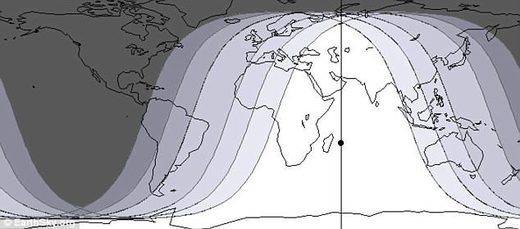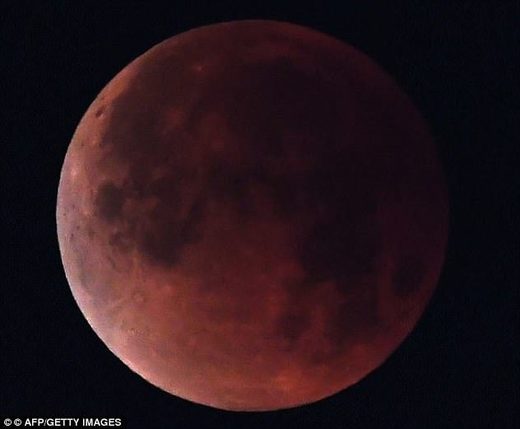SIGNS IN THE SKIES: Spectacular 'blood moon' on July 27 will be the longest lunar eclipse this century: Here's when and how to see it
Skygazers can enjoy the longest lunar eclipse of the 21st century next month.
The lunar event, which takes place on July 27, will be visible to most people living in the Eastern hemisphere and will last for 103 minutes - four minutes short of the longest possible duration an eclipse could last.
Blood moon in Australia: July 28thThe rare celestial event is the result of several astronomical events aligning, which will prolong the phenomenon.
According to EarthSky, here's when you'll be able to enjoy the show in Australia on July 28th (times in AEST):
3.14am: Eclipse begins
5.30am: The moon can be seen at is reddest
6.21am: Maximum eclipse
7.13am: Total eclipse ends
During the eclipse, the moon will pass through Earth's darkest shadow, known as umbra, causing it to take on a red sheen, giving rise to the 'blood moon' name.
No equipment is needed to view the event, with the naked eye more than enough to watch the century's most impressive eclipse.
Unlike a solar eclipse, where the moon crosses the path of the sun, it is perfectly safe to look directly at the lunar eclipse.
People hoping to enjoy the 'blood moon' need only to hope for clear skies.
The total eclipse is set to last for 1 hour 43 minutes, but a partial eclipse will be visible for almost four hours.
The total eclipse begins at 7:30 pm UTC (8:30 BST), and ends at 9:13 pm UTC (10:13 BST).
The peak of the eclipse will occur at 8:22 pm UTC (9:22 BST).
Mathematically, the longest an eclipse could ever last is 1 hour 47 minutes, and the longest eclipse of the 20th Century (1901-2000) happened on July 16, 2000.
This period of total eclipse lasted for 1 hour 46.4 minutes.
Only those in the Eastern Hemisphere will be able to view the upcoming event, with people in Europe, Africa and Asia getting the best seats for the lunar show.
Skygazers in South America will be able to see part of the final stages of the eclipse just after sunset on July 27.
In contrast, New Zealanders will be able to watch the start of the eclipse before sunrise July 28.
It will not be visible at all in the United States.
Parts of central Asia, the Middle East and Eastern Africa will see the lunar eclipse in its entirety.
The UK falls slightly outside of the ideal viewing range, meaning people will see the total eclipse for only 84 of the 103 total minutes.
This is due to the moon being below the horizon in Britain when the eclipse begins.
To get the best view of the eclipse, make sure you are in an area with low-light pollution. For example, high vantage points in a built-up area, or ideally, a trip to the countryside should provide the best view.
Those who want to photograph the lunar transit will be able to do so with a bit of patience, a telescope and the right app.
Both Android and iOS have apps available to help capture a picture of the event.
HOW CAN YOU SEE THE BLOOD MOON TOTAL LUNAR ECLIPSE?
The total lunar eclipse on July 27 will be visible to large swathes of the Eastern hemisphere.
It will reach peak eclipse at 9:22 (BST), however, the total eclipse will last for a total of 1 hour 43 minutes.
Skygazers in South America will be able to see part of the final stages of the eclipse just after sunset on July 27.
In contrast, New Zealanders will be able to watch the start of the eclipse before sunrise July 28.
It will not be visible at all in the United States.
Parts of central Asia, the Middle East and Eastern Africa will see the lunar eclipse in its entirety.
The UK falls slightly outside of the ideal viewing range, meaning people will see the total eclipse for only 84 of the 103 total minutes.
This is due to the moon being below the horizon in Britain when the eclipse begins.
Although the moon will be smaller than usual due to its distant position in its orbit, it will still be visible with the naked eye.
If the sky is clear, looking up at the moon will be enough to witness the shadow of Earth crossing its surface.
A telescope will undoubtedly enhance this, but is not essential.
Unlike a solar eclipse, where the moon crosses the path of the Sun, it is perfectly safe to look directly at the lunar eclipse.
Areas with low light pollution will see a clearer eclipse.
To escape this omnipresent glow, head to a high vantage point or the countryside.

© EarthSky.org
Parts of central Asia, the Middle East and Eastern Africa will see the lunar eclipse in its entirety, as the moon will be directly above Madagascar. The UK falls slightly outside of the ideal range, meaning people will the total eclipse for only 84 minutes
Parts of central Asia, the Middle East and Eastern Africa will see the lunar eclipse in its entirety, as the moon will be directly above Madagascar. The UK falls slightly outside of the ideal range, meaning people will the total eclipse for only 84 minutes
WHAT IS A LUNAR ECLIPSE?A lunar eclipse occurs when the sun, Earth, and moon fall in line with one another, bringing the moon into line with the shadow cast by the Earth.
An eclipse occurs any time a planet or moon passes between another planet, moon or the sun.
Depending on their orbits, they can be total or partial.
A lunar eclipse is a specific event which happens when Earth lines up directly between the sun and the moon.
When this happens, Earth blocks the light from the sun to the moon. Earth's shadow then falls on the moon.
During a lunar eclipse, we can see Earth's shadow on the moon.
They can last for several hours, but it is rare for a period of total eclipse to last longer than 100 minutes.
At least two lunar eclipses happen every year.
When this happens, Earth blocks any sunlight hitting the moon, and casts its own shadow onto its surface as well.
Lunar eclipses can be extended based on the location of the moon in its orbit.
For the upcoming eclipse, the moon will also be at its farthest point from Earth, known as apogee.
As a result, the moon will look smaller than usual, and consequently, the time it takes to cross through the shadow cast by the Earth will be longer then usual.
The last notable lunar event was at the start of 2018, when a 'super blood blue moon' graced our skies.

© AFP/Getty Images
The last notable lunar event was at the start of 2018, when a 'super blood blue moon' graced our skies (pictured)
The last notable lunar event was at the start of 2018, when a 'super blood blue moon' graced our skies (pictured)
This is the result of a blue moon - the second full moon in a calendar month - occurring at the same time as a super moon, when the moon is at perigee and about 14 per cent brighter than usual.
It also combined with a blood moon, the moment during a lunar eclipse when the moon, which is in the Earth's shadow, takes on a reddish hue.
'It's an astronomical trifecta,' Kelly Beatty, a senior editor at Sky and Telescope magazine, said at the time.
'That red light you see is sunlight that has skimmed and bent through Earth's atmosphere and continued on through space to the moon,' said Alan MacRobert of Sky and Telescope magazine.
'In other words, it's from all the sunrises and sunsets that ring the world at the moment.'
The upcoming lunar eclipse will be swiftly followed by another rare celestial event, as Mars is set to orbit closer to Earth than it has for 15 years.
Throughout the month of July, the orbit of Mars and Earth will align in a rare phenomenon known as perihelic opposition.
This occurs when Mars reaches its closest point to the sun at the same time as Earth's orbit brings it directly between the two.
Perihelic opposition, which will also make the red planet appear brighter, can be seen with the naked eye.
Stargazers all over the world will be able to see the red planet, although those in the southern hemisphere will get the best view.
In the days before Mars Close Approach, the planet will look around three times brighter in our sky than it normally does.
It will also outshine Jupiter, registering as 1.8 times brighter in the night sky.
That means Mars will temporarily become the fourth-brightest object in the sky, ranking after the sun, the moon and Venus.
Mars will be up all night, rising after sunset and setting at sunrise.
Mars should be visible in the southeast, located just below the Sagittarius constellation.
HOW TO VIEW MARS IN THE NIGHT SKY, AS RED PLANET PASSES CLOSER TO EARTH THAN USUAL
On July 27, Mars will pass closer to Earth than it has done for 15 years.
The phenomenon, known as perihelic opposition, will make the red planet appear larger and brighter than normal in the night sky.
The rare event occurs when Mars reaches its closest point to the sun as the same time as Earth's orbit brings it directly between the two.
Although the actual point of opposition will take place on July 27, Mars will be noticeably larger for the majority of the month of July.
Perihelic opposition can be seen with the naked eye, meaning there's no need for expensive equipment for stargazers to spot the rare event next month.
It will outshine Jupiter, registering as some 1.8 times brighter in the night sky.
Mars will be up all night, rising after sunset and setting at sunrise.
Stargazers hoping to spot the red planet from the northern hemisphere should check the sky in the hours before dawn.
Mars should be visible in the southeast, located just below the Sagittarius constellation.
Meanwhile, the best view of the phenomenon will be enjoyed in the southern hemisphere.
For example, New Zealand capital Wellington will enjoy a view of the red planet as it reaches a maximum altitude of 74 degrees in the sky at the end of July.
SOURCE
